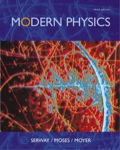
Concept explainers
The Q-value of the reactions in proton-proton cycle and the overall Q-value.
Answer to Problem 36P
The Q-value of the reactions in proton-proton cycle is
Explanation of Solution
Write the first reaction in proton-proton cycle
Here,
Write the expression for Q-value of this reaction
Here,
Write the second reaction in proton-proton cycle
Here,
Write the expression for Q-value of this reaction
Here,
Write the third reaction in proton-proton cycle
Here,
Write the expression for Q-value of this reaction
Here,
Write the fourth reaction in proton-proton cycle
Here,
Write the expression for Q-value of this reaction
Here,
Write the fourth reaction in proton-proton cycle
Write the expression for Q-value of this reaction
Here,
Conclusion:
Substitute
Substitute
Substitute
Substitute
Substitute
Therefore, the Q-value of the reactions in proton-proton cycle is
Want to see more full solutions like this?
Chapter 14 Solutions
EBK MODERN PHYSICS
- Given the following two nuclear reactions, reaction 1: 235U + n → 140Xe + 94Sr + 2n reaction 2: 4(1H) + 4e− → 4He + 2ν + 6γ + 2e− (a) Identify each reaction (b) Which reaction releases most energy? justify (c) How long would the energy released from each reaction sustain a 100W light bulb?arrow_forwardCalculate the wetting angle for a solid nucleus attached to a mold wall, where the solid-liquid surface energy is 0.177, the solid-mold surface energy is 0.110, and the liquid-mold surface energy is 0.198 J/m2. Given these parameters, how much lower would the heterogeneous nucleation barrier be compared to the homogenous nucleation barrier?arrow_forwardThe power output of the Sun is 4 × 1026 W. Part (a) If 88 % of this is supplied by the proton-proton cycle, how many protons are consumed per second? Part (b) How many neutrinos per second should be incident on every square meter of the Earth from this process? This huge number is indicative of how rarely a neutrino interacts, since large detectors observe very few per day.arrow_forward
- If the average energy released in a fission event is 208 MeV, find the total number of fission events required to operate a 100.-W lightbulb for 1.0 h.arrow_forward(a) Calculate the energy released in the neutron-inducedfission reactionn + 239Pu → 96 Sr + 140Ba + 4n,given m(96 Sr) = 95.921750 u andm(140 Ba) = 139.910581 u .(b) Confirm that the total number of nucleons and total chargeare conserved in this reaction.arrow_forwardKnown the rest energy for (233,92 U) is E_u=233.039u, with 1u=931.5MeV. he rest energies for one proton and one neutron are 938.27 MeV, 939.56 MeV, respectively.Compute the binding energy of (233,92 U) and the binding energy per nucleon.arrow_forward
- Show that the total energy released in the proton-protoncycle is 26.7 MeV, considering the overall effect in1H + 1H → 2H + e+ + ve , 1H + 2H → 3 He + γ , and3 He + 3He → 4 He + 1H + 1H and being certain to include the annihilation energy.arrow_forward(a) Find the total energy released in MeV in each carbon cycle (elaborated in the above problem) including the annihilation energy. (b) How does this compare with the proton-proton cycle output?arrow_forwardFind the Q-value for the nuclear reaction Be + He - C+n+o Given masses of Be = 9.01286 amu He = 4,00388 amu C = 12.000 amu !! bn = 1.00866 amuarrow_forward
- The natural fission reactor discussed in Module 43-3 is estimated to have generated 15 gigawatt-years of energy during its lifetime. (a) If the reactor lasted for 200 000 y, at what average power level did it operate? (b) How many kilograms of 235U did it consume during its lifetime?arrow_forwardAssume that a plasma temperature of 1 * 108 K is reached in a laser-fusion device. (a) What is the most probable speed of a deuteron at that temperature? (b) How far would such a deuteron move in a confinement time of 1 * 10-12 s?arrow_forwardHow much energy in MeV would be required to completely dissociate the uranium-235 nucleus (atomic mass=235.043923), into its components’ protons and neutrons?arrow_forward
 Modern PhysicsPhysicsISBN:9781111794378Author:Raymond A. Serway, Clement J. Moses, Curt A. MoyerPublisher:Cengage Learning
Modern PhysicsPhysicsISBN:9781111794378Author:Raymond A. Serway, Clement J. Moses, Curt A. MoyerPublisher:Cengage Learning
